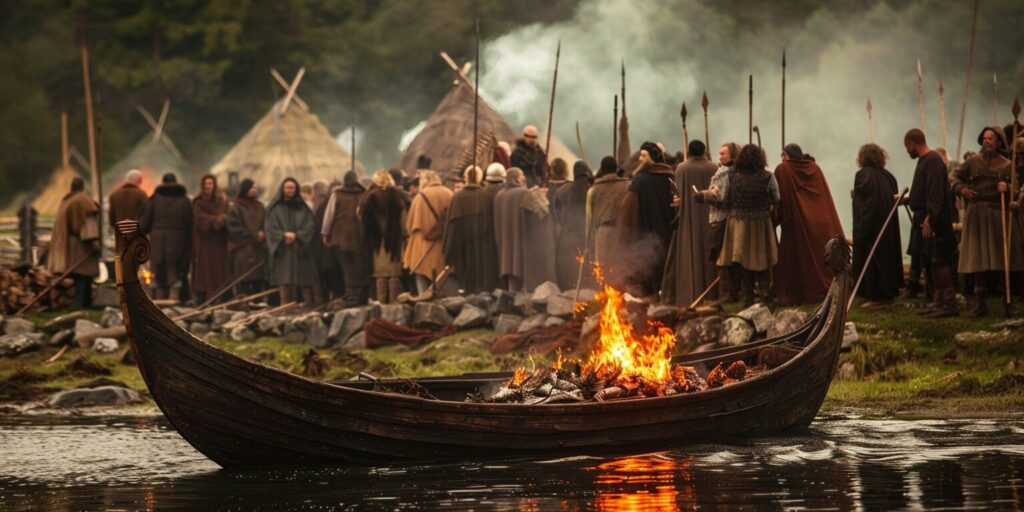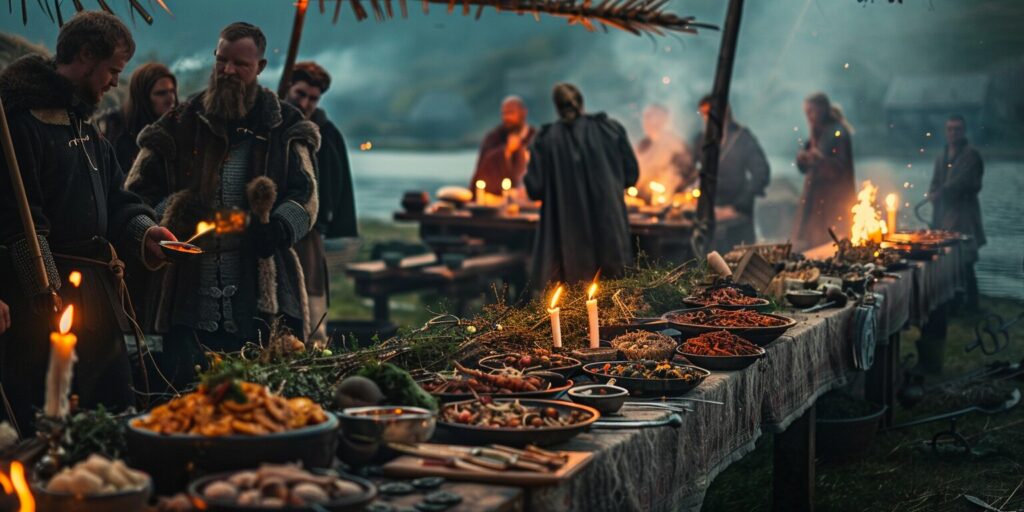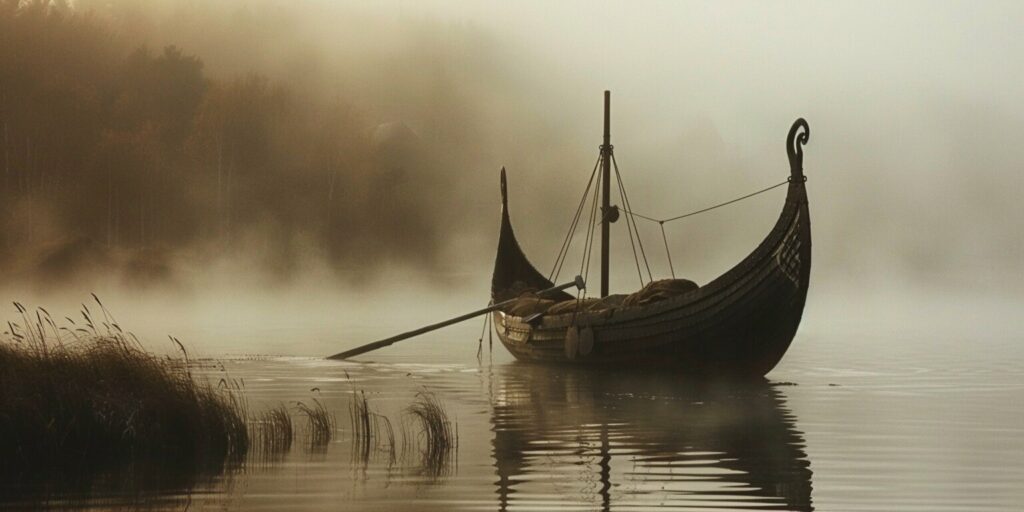Daily Life in the Viking Age, Vikings
Ancient Farewells: Understanding Viking Funeral Customs and Traditions
Welcome to a deep dive into Viking funeral customs and traditions. We’ll examine how Norse society honored their dead. This includes the use of cremation and burial ships, shedding light on their meanings.
What is a Viking Funeral?
A Viking funeral was a special goodbye for the departed in Viking culture. It was a serious event, carrying great meaning. These rituals showed the Vikings’ views on death and the afterlife.
Cremation was a key part of Viking funerals. The body was put on a pyre, and the rising smoke was thought to carry the spirit to the ancestors. Thus, cremation helped the soul start its afterlife journey.
Burial ships were also used. These ships were not for sailing but for the afterlife journey. They symbolized the deceased’s honor and status. They were filled with items for their next life, showing their readiness.
Viking funerals were customary, and their details varied depending on the person’s status and region. They included special prayers and offerings to ask for protection and help in the person’s afterlife journey.
The Vikings deeply respected their dead. Their rituals aimed to stay connected with them, and these traditions showed a strong belief in life after death.
Viking Funeral Customs and Traditions
Viking funeral rituals were a big part of their culture. They held these ceremonies to honor and help the dead on their journey after death. These traditions were key in Norse life, showing their deep beliefs about life and death.
At a Viking funeral, many steps were taken to say goodbye properly. This included prayers and giving things to the person who had passed. Friends and family came together to show their love and respect.
A main feature was burning the body in a pyre. The Vikings believed the smoke and fire would lead the spirit to the next life, and this act was central to how they handled funerals.
Rituals and Offerings
- Prayers: People would chant and pray to ask the gods to watch over the departed.
- Funeral Pyres: The body was set on fire, showing the change from body to spirit.
- Offerings: Items and even animals were burned with the person, believed to help them in the next life.
- Libations: Drinks were poured on the pyre to honor and feed the person’s spirit.
These acts were a sign of love for the lost one. They made sure the departed felt welcome in the afterlife. For the living, it was a way to mourn and say their final goodbye.
Viking funerals could be different depending on where they were and who the person was. The richer or more important someone was, the grander the funeral.
These customs reveal a great deal about the Norse people. They tell us how they viewed life, death, and the connection between this world and the next. They also provide a window into their deep spiritual beliefs.
Historical Viking Cremation Practices
The Vikings followed unique funeral customs. They believed cremation helped the spirit move on peacefully.
They used pyres to burn the bodies. This act saw fire as purifying and freeing the spirit. It showed respect and helped the person journey to the gods’ realm.
Mourners would surround the pyre, pray, and give items to help the deceased in the afterlife. These could be personal items, weapons, or even animal sacrifices.
After burning, the ashes were collected. They were then put into urns or buried in mounds, highlighting a strong link between the earthly and spiritual worlds.
Methods and Rituals Surrounding Viking Cremation
- Vikings used funeral pyres to cremate the bodies of the deceased.
- The funeral pyre was set ablaze, symbolizing the release of the spirit.
- Mourners offered prayers and made offerings to accompany the deceased on their journey.
- The ashes of the cremated individuals were either placed in urns or buried in mounds or tumuli.
Viking cremation was deeply meaningful. It affected how future generations viewed death and the journey to the afterlife. Today, these practices still captivate and teach us about old Norse beliefs.
Burial Ships and Their Symbolism
Viking funeral customs included the use of burial ships, which were central to how they honored the dead. These majestic vessels played a vital part in the mourning and remembrance process.

Skilled craftsmen carefully built these ships. Each ship was unique, featuring detailed carvings and decorations. These creative elements showcased the artistry of Viking culture.
The ships symbolized a journey to the afterlife. A Viking warrior’s adventures inspired this idea in life. Just as they voyaged to new lands, the ship was their guide to the afterlife.
They believed the ship guaranteed a safe and successful afterlife journey, making it a powerful symbol of protection and direction for the soul.
Burial ships came with items like weapons, jewelry, and food. These items were thought to help the deceased in their afterlife journey. They were seen as essential provisions for the next life.
The ships were a way to show the family and community deep respect and honor. They were a grand tribute to the accomplishments of the departed.
Today, finding Viking burial ships sheds light on their burial customs. These discoveries provide valuable information to archaeologists and historians. They highlight the intricate practices of Viking society.
Traditional Norse Funerals: Beyond Viking Customs
Viking funerals are well-known, but Norse funeral traditions go far beyond burning ships. Traditional Norse burials cover many customs like mound and ground burials. Each type of burial carries its own special meaning.
Mound burials were a common Norse custom. The deceased were laid in a mound with gifts and offerings. These mounds marked their grave and showed their ongoing role in the community.
Ground burials were also used. Here, the dead were laid to rest on the earth, sometimes in specific areas or family plots. This simple way of burial highlighted the Norse view of life’s connection with nature and the eternal cycle.
It’s key to remember that funeral practices changed by region. The Norse world, spanning from Scandinavia to beyond, had diverse customs. These were shaped by local beliefs and traditions, enriching the tapestry of Norse burial customs.
Mourning and Commemoration in Norse Culture
In Norse culture, mourning and remembering the dead were very important. This helped keep the memories of the departed alive. They used many rituals and traditions to show their respect.
Feasts and Gatherings
Feasting and gathering were common ways to honor the deceased. Family and friends would join in these events, sharing meals, drinks, and tales of the departed. This collective sorrow helped everyone feel connected and supported.

Poetry and Eulogies
Norse grieving customs heavily featured poetry. Skalds, or poets, created moving verses in memory of the dead. These poems praised the achievements and good qualities of the deceased.
Reading these poems at funerals was comforting. It reminded the living of the positive aspects of the one they lost.
Storytelling and Oral Tradition
Telling stories was crucial in Norse mourning. It was a way to keep the memories of the dead alive. Stories of heroism and family lineage were shared through generations, helping maintain cultural values and links between the past and present.
Norse mourning was about remembering life rather than just grief. They celebrated their loved ones’ lives through feasting, poetry, and stories. These activities kept their culture strong and offered comfort in the memory of the departed.
The Role of Death in Viking Society
Death was extremely important in Viking society, shaping their beliefs about life and the afterlife. Viking funerals’ unique customs give us insight into how they viewed death and what came after.
Beliefs about the Afterlife
Vikings saw the afterlife as a place to continue what they did on Earth. This meant fighting and feasting in Valhalla, a hall for brave warriors ruled by Odin. They thought dying in battle was the best way to go.
They also believed in other worlds like Helheim for the dead and Niflheim of cold and darkness. These ideas affected how they performed funerals and rituals.
The Role of Warriors
Warriors were highly honored in Viking culture. When they died, they had grand funerals. These events celebrated their courage and prepared them for the afterlife. Warriors were sent off with their weapons and armor.
Vikings thought slain warriors kept watching over their families and lands. So, a warrior’s death was just a change in their service to society. It wasn’t the end of their story.
Connections to Norse Mythology
Norse myths about gods and creatures greatly impacted Viking funeral traditions. Stories of Odin, Thor, and Freya helped Vikings understand and deal with death.
They believed that burning the dead could secure a good path in the afterlife. These acts helped connect the deceased with the strength of the Norse gods.
Viking death rituals were also about keeping peace and order. They linked the gods’ world with the living, giving comfort to those who lost someone.
Impact and Legacy of Viking Funeral Practices
Viking funeral customs have deeply influenced today’s cultures and funeral rites. They still hold special meaning, with parts of these old customs seen in some traditions today.
One standout legacy is the use of burial ships. The famous scene of a warrior on a fiery ship sailing into the afterlife is well-known. This has shaped how people think about burials, with a focus on symbolism like using boats and related ceremonies.
The Vikings placed great emphasis on honoring and celebrating the lives of those who passed. Feasting, sharing poems, and telling stories were key in Viking funerals. These acts helped remember and honor the dead. A similar spirit lives on in today’s memorial services and life celebrations.
Viking death rites’s impact goes further into the arts. They inspire works across various mediums like books, films, and paintings. The legacy of Viking rituals remains alive in our culture’s creative expressions.
Modern Traditions Influenced by Viking Funerals:
- Naval-themed burials and ceremonies
- Cremation rituals and practices
- Memorial feasts and celebrations of life
- Symbols and motifs inspired by Viking culture
- Artistic representations in literature, film, and other forms of media
Viking funerals teach us about Norse culture and beliefs on life and death. They show a deep link with the afterlife. These customs help us understand the Norse people’s spirituality and values.
In short, Viking funerals significantly impact how we view death and celebrate life. Their customs remind us to honor and remember those who have passed, even in our times.
Conclusion
Viking funerals are very important in the Norse world. They give us a look into the old Norse beliefs and ways. This article has shown us how they treated their dead with respect. They used burnings and put people on ships for the afterlife.
We’ve examined what old stories and finds tell us about Vikings. They celebrated the dead with big fires, fancy ships, and shared meals. Every step showed how life, death, and the spiritual world were connected to them.
Viking funerals are not just part of the past. Today, many cultures still remember their dead in similar ways. This shows how Viking traditions have influenced our customs. Their funeral ways teach us a lot about their world and beliefs.
Studying Viking funerals helps us see how important remembering the dead was to them. It’s part of a bigger story of human rituals. We see that honoring our past is still very powerful today.

